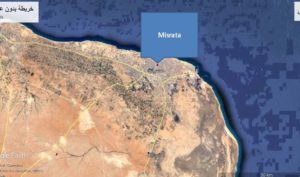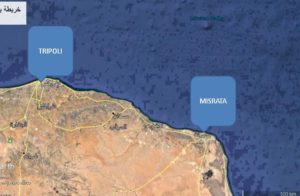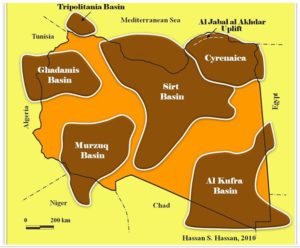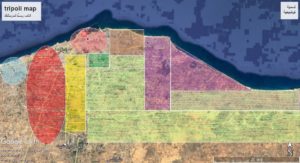Misrata
About:
It is a city in the Misrata District in northwestern Libya, situated 187 km (116 mi) to the east of Tripoli and 825 km (513 mi) west of Benghazi on the Mediterranean coast near Cape Misurata. With a population of about 281,000, it is the third-largest city in Libya, after Tripoli and Benghazi. It is the capital city of the Misrata District and has been called the trade capital of Libya. The harbor is at Qasr Ahmad.
Revelation:
 Starting on 20 February 2011, small demonstrations took place in Misrata in solidarity with anti-government protesters in Benghazi. Libyan police immediately arrested the Misratan protesters, sparking larger demonstrations which Libyan government forces sought to quell using live ammunition. Within a few days, 70 protesters were killed provoking outrage among the city’s inhabitants. By 24 February, the city fell under the control of anti-Gaddafi forces in the Libyan uprising against Gaddafi That same day, Gaddafi regime forces attempted to wrest control of the city but were repelled.
Starting on 20 February 2011, small demonstrations took place in Misrata in solidarity with anti-government protesters in Benghazi. Libyan police immediately arrested the Misratan protesters, sparking larger demonstrations which Libyan government forces sought to quell using live ammunition. Within a few days, 70 protesters were killed provoking outrage among the city’s inhabitants. By 24 February, the city fell under the control of anti-Gaddafi forces in the Libyan uprising against Gaddafi That same day, Gaddafi regime forces attempted to wrest control of the city but were repelled.
 The battle was renewed with shelling on 20 March as pro-Gaddafi tanks and artillery pushed forward and besieged Misrata. Eyewitnesses reported that pro-Gaddafi soldiers were shooting, killing and injuring unarmed civilians. The city was shelled by artillery, tanks, and snipers, and for over 40 days and had its water supply shut off by Gaddafi’s forces By late April, over 1,000 people in the city were reported killed while around 3,000 were injured. With air support from NATO which entered the conflict on the rebels’ side on March 19, and a vital sea-based life line from neighboring country the Island of Malta anti-Gaddafi forces managed to force loyalist troops to retreat on April 21, gaining control of most of the city by mid-May.
The battle was renewed with shelling on 20 March as pro-Gaddafi tanks and artillery pushed forward and besieged Misrata. Eyewitnesses reported that pro-Gaddafi soldiers were shooting, killing and injuring unarmed civilians. The city was shelled by artillery, tanks, and snipers, and for over 40 days and had its water supply shut off by Gaddafi’s forces By late April, over 1,000 people in the city were reported killed while around 3,000 were injured. With air support from NATO which entered the conflict on the rebels’ side on March 19, and a vital sea-based life line from neighboring country the Island of Malta anti-Gaddafi forces managed to force loyalist troops to retreat on April 21, gaining control of most of the city by mid-May.
Thereafter, forces from Misrata played an important role in other theaters of the war, such as the Battle of Tripoli, the Battle of Sirte and the Battle of Bani Walid (2011).
Military Situation:
The city is under the military council control, since the revolution started in 2011.
There are many militias within the city and the most important:
- The Marsa Brigade led by Salah Badi
- Halabus Brigade led by Mohammed Al Haddad
- The Mahjoub Brigade led by Tariq Nadori
- National Guard led by Mahmoud al-Zaql
- The Anti-Terror force led by Shrokhan
Misratah’s forces were among the first to fight ISIS in the city of Sirte, However some battalions still has footprint in Sirte as anti-terror forces to control and secure the city, the forces securing Sirte:
- The Brave Battalion
- The Island Battalion
- Libya Shield Battalion
- Black Valley Battalion
- National Guard Battalion
- Martyrs’ Brigade
- Battalion of the Mother of Battles
- Republic Battalion
- Badr Battalion
- Support Battalion
- The 604th Salafist Battalion
- Martyr Salik Al – Zraidi Battalion
- Tariq Bin Ziad Battalion
- Hittin Battalion
- Heavy Martyrs Battalion
- Merbat Battalion
- The Lion Battalion
- The Battalion of Astronauts
- Battalion Tajine – Tanks
- Obstacle Battalion
- A Battalion in the way of Allah
- East Coast Battalion
- Brotherhood Battalion
- The City Wall Battalion
- Al – Mirdas Battalion
- Unity Battalion
- The Martyr Younis Battalion
- Desert Battalion
- The Ruseifeh Battalion
- The Faisal Battalion
Main Players in Misrata:
- Ahmed Mitiq – Deputy Prime Minister
- Abdurahman Alswehlee – Head of High Council of State
- Mohammed Al-Heddad – Commander of Central Military Zone
- Salah Badi – Leader of Almarsa Militia
Benghazi:
About:
 Benghazi is the second-most populous city in Libya and the largest in Cyrenaica. A port on the Mediterranean Sea in the Kingdom of Libya, Benghazi had joint-capital status alongside Tripoli, possibly because the King and the Senussi royal family were associated with Cyrenaica rather than Tripolitania.
Benghazi is the second-most populous city in Libya and the largest in Cyrenaica. A port on the Mediterranean Sea in the Kingdom of Libya, Benghazi had joint-capital status alongside Tripoli, possibly because the King and the Senussi royal family were associated with Cyrenaica rather than Tripolitania.
Military Situation:
Since the end of the battles in Benghazi in 2017 and the Libyan national army and the security services control the city.
After the elimination of the armed and terrorist groups and there is relative stability in the security and economic situation, Recently, the oil and gas exhibition was organized in the city with the participation of several local and foreign companies.
 The most important security and military battalions:
The most important security and military battalions:
- The 106th Brigade is headed by Saddam Haftar
- Tariq Bin Ziad battalion led by Khalid Hafter
- The lightning forces led by Major General Abu-Hamdah
- Criminal Investigation Service led by Salah Howeidi
Structure of the General Command of the Libyan Army:
- Commander General – Marshal Khalifa Hafter
- Chief of General Staff – Abdul Razzaq Al Nadori
- Chief of the General Staff – Major General Mabrouk Sahban
- Chief of Air Staff – Major General Saqr Al Jaroushi
Khalifa Hafter:
About:
Khalife Belkacem Hafer was born in 1943 in Ijdabia where he grew up and studied in the elementary and preparatory stages and memorizing the Holy Quran. He attended secondary school at Darna High School between 1961-1964. He joined the Royal Military College in Benghazi on September 16, 1964. He graduated in 1966 and was appointed by the Armored Corps.
He has received many military courses, including Team Leadership in Russia, with distinction. He led the war in Chad and won some victories until France intervened. After his victory he sought support for his army, but Muammar Gaddafi was not supported by a family in the valley of Dom. He received several military medals throughout his military history. He was the commander of the Libyan forces in the field during the crossing of the Suez Canal (October 1973 war)
Chad War:
He led the Libyan armed forces during the Libyan-Chadian war that began in 1980 and won there and occupied Chad in a short period. After asking Gaddafi for the support available at the time, the request was not implemented, fearing that he would return victorious and seize Libya’s rule. Haftar was captured in Chad along with hundreds of Libyan soldiers in the Battle of Wadi Dum on March 22, 1987. After the families, he and several of his fellow officers and soldiers broke away from Gaddafi in Chad’s prisons and were later released to leave the country after Idriss Deby came to power in Chad as part of a deal to be an opposition there.
He began digging in the prisons of Chad away from the Gaddafi regime, until he decided in late 1987 and a group of officers and non-commissioned officers and soldiers and recruits to join the ranks of the National Front to save the opposition Libya, and announced on June 21, 1988, the establishment of the Libyan National Army as a military wing of her under the leadership of Haftar. However, the Libyan National Army quickly ended, and its members were flown by American helicopters to the United States where it stayed. It continued to oppose the Gaddafi regime for 20 years.
17 FEB Revelation:
Hafar led an attempt to oust Gaddafi in 1993 but did not succeed and was sentenced to death in absentia. He returned from exile in March 2011 to join the February 17 revolution and was present in Benghazi before the entry of Qadhafi’s convoy on 19 March 2011. During the entry of the convoy he was present in the field near the southern entrance of Benghazi (the Tabalino bridge or the Tripoli bridge). Where he had a prominent role in supporting the rebels materially and morally on the fronts. During the restructuring of the Libyan National Army in November 2011, about 150 officers and noncommissioned officers agreed to nominate Khalifa Hafer as chief of staff.
Libya Dignity military operation (Karama) :
On May 16, 2014, Major General Khalifa Hafer announced the launch of the so-called “dignity process” or “dignity of Libya”, a military operation that he said was aimed at “cleansing Libya of terrorism, gangs and outlaws, abiding by the democratic process and ending assassinations especially targeting the army and the police.” Saying that the operation (not a coup and that the army will not exercise political life). He also announced the “freezing” of the work of the National Congress, whose opponents say its continuation has been illegal since February 7, 2014, and the maintenance of the emergency government.
The military operations, which resulted in the clash of forces of the Libyan National Army led by Major General Khalifa Hafer, were supported by leaders of the Libyan armed forces in various parts of Libya, including the Marj, Tobruk, Tripoli, Zintan and Benghazi, and between hardline Islamic militias such as Ansar al-Sharia, Allah al-Sahati and armed groups from Darnah. There were also clashes between military forces that announced their accession to the Karama operation and Islamic militias in Tripoli.
The interim government, headed by Abdullah al-Thani, announced its bias towards it at a press conference announcing that the National General Conference in Libya was responsible for the failure to build the army and police in the country. His predecessor, Ali Zidane, also expressed his full support for the Karama process, provided that it does not interfere in the political process in the country.
About Oil Industry in Libya:
Libya’s oil reserves are estimated at 46.4 billion barrels and Libya ranks ninth in the world in terms of oil reserves.
Libya’s oil production in 2010 reached 1.65 million bpd.
Libyan oil is divided into four main basins:
- Sirte Basin
- Ghadames Basin
- Merzak Basin
- Maritime Tribolana Basin
Sirte Basin
It is one of the most important and youngest basins. It is located in the center of eastern Libya. It has 16 producing fields. The total recoverable oil is more than 500 million barrels and more than 33 trillion cubic feet of gas.
Among the fields of the Sirte basin, the bed field is Libya’s largest production field ever and is owned by the Arabian Gulf Oil Company. The total reserves in the basin are estimated at more than 117 billion barrels equivalent, equivalent to 89% of the total oil discovered in Libya.
At the global level, the basin is ranked 13th in terms of hydrocarbons, the first in Africa in terms of abundance of production. The basin produces “sweet oil” (API 44-32), sulfur content is very low between 0.15% and 0.66%, and the largest fields produce about 200 thousand barrels per day in 2011.
Ghadames Basin
Covering an area of 390 thousand square kilometers, is located to the north-west of Libya, and parts of it in Tunisian and Algerian territory, and contains the basin 3.5 billion barrels equivalent capacity of the production in 2009 to about 950 million barrels of equivalent, West Libya gas project.
Merzak Basin
Covering the vast area in the southwest, and has an extractable reserve of more than 5 billion barrels of equivalent, which is the field of spark, which reached production in September 2011 to 400 thousand barrels per day, and the field of the oil elephant, which reached the peak production of 125.7 thousand barrels per day
Tribulation of the Marine Basin
It is located in the Libyan waters to the north-west towards the city of Sabratha, 121 km from Tripoli, the capital, and is located Bouri marine field, which has a recoverable reserves of two billion barrels of oil, and is the largest discovery in the Mediterranean so far, and the field produced 45 thousand barrels per day By the end of 2009.
Oil Sites under the control of the Libyan Army:
- Sirte Basin
- Alkoufra Basin
- Sidra Oil Port
- Ras Lanuf Oil Port
- Port of Brega Oil
- Port of Zuwaitina Oil
Oil Sites under GNA Control :
- Ghdames Basin
- Morzouq Basin
- Tripolitana Basin
However, all oil sites in Libya are operating under the National Oil Corporation (NOC) located in Tripoli, and All export and sales operations are carried out through the National Oil Corporation (NOC) as well as contracting, drilling and exploration and Libyan oil revenues are set in the Libyan Central Bank. And there are many foreign companies of different nationalities working in Libya and the Libyan market is open and not limited to a specific country or company.
Libya suffers from the problem of smuggling oil derivatives such as gasoline and diesel. Large quantities are smuggled daily and sold on the Tunisian, Maltese and Italian black market due to their cheap price.
Libya is one of the richest countries in the Arab world and Africa, but it does not have an advanced infrastructure, a successful education system or a good health system. Since Colonel Qaddafi took power, financial and administrative corruption has spread throughout the country.
The situation continued even after the revolution and even worsened. Most Libyans live below the poverty line, with an average per capital income of $250 per month.
Libya officially the State of Libya, is a country in the Maghreb region in North Africa, bordered by the Mediterranean Sea to the north, Egypt to the east, Sudan to the southeast, Chad and Niger to the south and Algeria and Tunisia to the west. The sovereign state is made of three historical regions: Tripolitania, Fezzan and Cyrenaica. With an area of almost 1.8 million square kilometres (700,000 sq mi), Libya is the fourth largest country in Africa, and is the 16th largest country in the world. Libya has the 10th-largest proven oil reserves of any country in the world. The largest city and capital, Tripoli, is located in western Libya and contains over one million of Libya’s six million people. The second-largest city is Benghazi, which is located in eastern Libya.
 Libya has been inhabited by Berbers since the late Bronze Age. The Phoenicians established trading posts in western Libya, and ancient Greek colonists established city-states in eastern Libya. Libya was variously ruled by Carthaginians, Persians, Egyptians and Greeks before becoming a part of the Roman Empire. Libya was an early centre of Christianity. After the fall of the Western Roman Empire, the area of Libya was mostly occupied by the Vandals until the 7th century, when invasions brought Islam to the region. In the 16th century, the Spanish Empire and the Knights of St John occupied Tripoli, until Ottoman rule began in 1551. Libya was involved in the Barbary Wars of the 18th and 19th centuries. Ottoman rule continued until the Italian occupation of Libya resulted in the temporary Italian Libya colony from 1911 to 1947. During the Second World War, Libya was an important area of warfare in the North African Campaign. The Italian population then went into decline.
Libya has been inhabited by Berbers since the late Bronze Age. The Phoenicians established trading posts in western Libya, and ancient Greek colonists established city-states in eastern Libya. Libya was variously ruled by Carthaginians, Persians, Egyptians and Greeks before becoming a part of the Roman Empire. Libya was an early centre of Christianity. After the fall of the Western Roman Empire, the area of Libya was mostly occupied by the Vandals until the 7th century, when invasions brought Islam to the region. In the 16th century, the Spanish Empire and the Knights of St John occupied Tripoli, until Ottoman rule began in 1551. Libya was involved in the Barbary Wars of the 18th and 19th centuries. Ottoman rule continued until the Italian occupation of Libya resulted in the temporary Italian Libya colony from 1911 to 1947. During the Second World War, Libya was an important area of warfare in the North African Campaign. The Italian population then went into decline.
Libya became independent as a kingdom in 1951. A military coup in 1969 overthrew King Idris I. The “bloodless” coup leader Muammar Gaddafi ruled the country from 1969 and the Libyan Cultural Revolution in 1973 until he was overthrown and killed in the 2011 Libyan Civil War. Two authorities initially claimed to govern Libya: the Council of Deputies in Tobruk and the 2014 General National Congress (GNC) in Tripoli, which considered itself the continuation of the General National Congress, elected in 2012. After UN-led peace talks between the Tobruk and Tripoli governments, a unified interim UN-backed Government of National Accord was established in 2015, and the GNC disbanded to support it. Parts of Libya remain outside either government’s control, with various Islamist, rebel and tribal militias administering some areas. As of July 2017, talks are still ongoing between the GNA and the Tobruk-based authorities to end the strife and unify the divided establishments of the state, including the Libyan National Army and the Central Bank of Libya.
Libya is a member of the United Nations (since 1955), the Non-Aligned Movement, the Arab League, the OIC and OPEC. The country’s official religion is Islam, with 96.6% of the Libyan population being Sunni Muslims.
1.Tripoli Region
Is located in the north west of the country, and it’s the official residence for the Government of National Accord and High council of state.
The two main cities are Tripoli and Misratah , however Each city in the province has a military council and a municipal council of its own.
In the city of Tripoli the militias situation is different There are a number of militias that control the city.
- Radaa forces
Witch is the militia controlling the area of Souq Aljoumaa and Mitiga Airport , them main duties is dealing with serious crimes ( kidnapping , ISIS threat, etc) - Nwasi militia (8th squad)
This militia is controlling the commercial area of the city (Tripoli towers , Dat Alemad towers, Aboulaiala towers , Tripoli seaport) - Tripoli rebels battalion (First squad)
It is considered one of the strongest militias in Tripoli and controlling a many state ministries. This militias duties is securing the diplomatic missions , Vital facilities of the GNA , Banks , checkpoints around the city. - Zentan militia (General security)
This militia is originally from the city of Zentan (200km south of Tripoli) and the Government of GNA assigned this militia to based in Tripoli to help and secure some areas and locations after the fighting with the 7th brigade.
- Ghnewa militia (Central Security Abou Salim Department)
This militia is controlling the area of Abou Salim and airport road.
- Janzour Knights militia
The main duties of this militia is securing the city of Janzour ( 20km east Tripoli ) , Palm city residence , and the UN main base. - Bab Tajoura militia
This militia is alien with the general intelligence and based in the area of Ras Hassan , Ben Ashour , and Noflieen them main duties is collecting intelligence information’s to help high authorities to fight organized crimes and high threats. - Albougra militia (55 brigade)
A local militia based in Tajoura (20km east of Tripoli) controlling the whole area east and east south of Tripoli , showed affiliation to Muslims brotherhood and the area controlled by this militia is a high risk area (carjacking , kidnapping , drugs, etc)
Key players of Tripoli militias
- Haithem Altajoure the leader of:
- Tripoli rebels brigade
- Diplomatic security
- First squad
Haithem Altajoure consider as the most powerful man in Tripoli and the west side of the country in general , he has very good relationship with Faiez Saraj ( the prime minister )
- Abd raouf Kara the leader of Radaa forces:
He is consider one of the Salafiest group in Libya , always travelling in big convoys and very well secured with his family. - Abdoulghani Alkikkli AKA Ghnewa the leader of Ghnewa militia:
Before the revelation he used to be an alcoholic dealer spend seven years in present , during the revolution he joined the rebels in his home town Kikkla ( 120km south of Tripoli ) and became the leader of his own militia.After that he returned to the area he lives in Tripoli with his militia and controlled it since 2011 until the present time.
He is affiliated to GNA government and taking his orders directly from MOI .
Map of Tripoli Region
Tripoli militias mapping:
Janzour knights
Zentan militia (general security)
Ghnewa militia
Nawasi militia
Bab tajoura militia
Radaa forces
Tripoli rebels brigade
55 brigade (Albougra militia)
The region of Cyrenaica (Barga) :
Cyrenaica was the name of an administrative division of Italian Libya from 1927 until 1943, then under British military and civil administration from 1943 until 1951, and finally in the Kingdom of Libya from 1951 until 1963. In a wider sense, still in use, Cyrenaica includes all of the eastern part of Libya, including the Kufra District. Cyrenaica borders on Tripolitania in the northwest and on Fezzan in the southwest. The region that used to be Cyrenaica officially until 1963 has formed several shabiyat, the administrative divisions of Libya, since 1995.
The 2011 Libyan Civil War started in Cyrenaica, which came largely under the control of the National Transitional Council (headquartered in Benghazi) for most of the war.[6] In 2012, the National Transitional Council declared Cyrenaica to be an autonomous region of Libya.[7][3
The main cities of Cyrenaica region:
- Benghazi
- Albaida
The political scene:
The legislature is the House of Representatives (located in Tobrouk).
The executive branch is the interim government (located in Albaida)
Military scene :
The Libyan national army controls the east side of the country Since the beginning of the process of libya dignity military operation Led by Marshal Khalifa Hafter.
About the battle of dignity:
The fighting began for the first time early on Friday, May 16, 2014. When Major General Khalifa Khafater attacked the headquarters of some Islamic militias in Benghazi, including those responsible for the killing of the US ambassador in 2012. Helicopters, aircraft and ground forces took part in the attack. Killing at least 70, and injuring more than 250. Hafter pledged not to stop until he eliminated extremist groups. Shortly before the attack, Huffer was said to have asked a close friend, “Am I a suicide?”
The operation, dubbed “Operation Karama” by Haftar, began when troops loyal to Major General Hafar attacked the units of the Martyrs’ Camp on February 17, the 1st Armored Battalion of Libya, and Ansar al-Shariah. The fighting was largely restricted to the south-western area of Benghazi “Hawari” and “Sidi Faraj”. The fighting was particularly concentrated between the southwest gate and the cement factory, the area controlled by the sharia advocates. Helicopters were part of the fighting and were seen flying around Hawari. The fighting also included the port city area between the Libyan navy and the Libyan Shield battalion.
Since the beginning of 2017, the Libyan army has full control of the region.
Map of The region of Cyrenaica (Barga) :
Map of the area LNA controls marked in red:
The region of Fezzan :
Is a historic area in the south-west of present-day Libya. Most of them are desert lands, but there are rocky mountains, highlands, dry rivers and valleys in the north. There are also many oases scattered in the Sahara, which depend on some villages in the water sources, but the main source of water in Fezan is groundwater. There is also a reserve of oil.
In the past, after the independence of Libya, Fezzan was a state known as the province of Fezzan or a governorate with an administrative system in Libya (besides the state of Tripoli and the state of Berqa). This system changed in the 1960s after the abolition of the state system to be replaced by smaller administrative divisions, namely, “the provinces” and then “municipalities”, which later changed to become the “popular” system.
In the past, the province of Fezan included the current peoples: Wadi al-Shati, Wadi al-Hayat, al-Jafra, Mersaq, Ghat and Sabha, the former capital of the region and the largest city in the region.
Political scene:
The region is affiliated to GNA ( the government of Tripoli ) In many cases, the region appears to be loyal to the government of the East for the purpose of obtaining financial support .
Natural sources:
It has huge reserves of crude oil and natural gas, some gold metals and large groundwater basins
Military scene:
The region is dominated by several armed groups, These groups, including tribal ones, were formed after the revolution, including those from outside Libya, such as the Chadian and Sudanese opposition .
Recently The Libyan national army began a large-scale military operation in the south of Libya to liberate it.
Map of Fezzan region:







